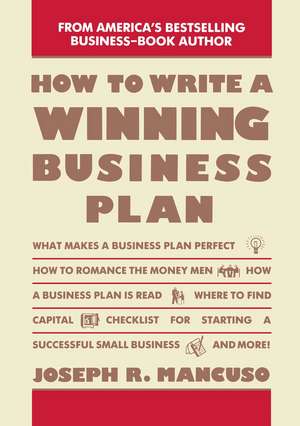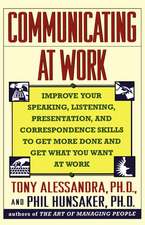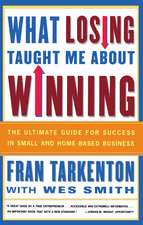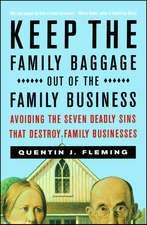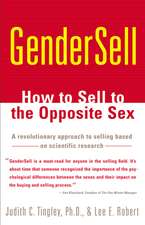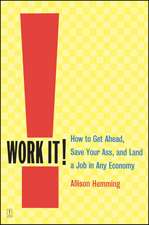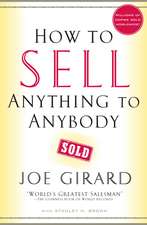How to Write a Winning Business Report
Autor Joseph R. Mancusoen Limba Engleză Paperback – 9 apr 1992
Joseph R. Mancuso offers key guidelines and valuable tips on how to gear your business plan to the people who control the cash. Featuring the original business plans from three highly successful businesses, plans that raised millions in upfront financing, How to Write a Winning Business Plan also reveals:
* What financiers look for in a plan
* Nine questions that every plan must answer
* How to prospect for financial sources
* How to romance the money men
* How to locate hidden sources of capital
* How to handle objections
* How to gain a commitment
* And much more
Complete with handy checklists and key financial forms, this book is your launch pad for a thriving business venture.
Preț: 213.26 lei
Nou
Puncte Express: 320
Preț estimativ în valută:
40.82€ • 44.35$ • 34.31£
40.82€ • 44.35$ • 34.31£
Carte disponibilă
Livrare economică 31 martie-14 aprilie
Preluare comenzi: 021 569.72.76
Specificații
ISBN-13: 9780671763589
ISBN-10: 067176358X
Pagini: 356
Dimensiuni: 178 x 254 x 20 mm
Greutate: 0.62 kg
Ediția:Reissue
Editura: Touchstone Publishing
Colecția Touchstone
ISBN-10: 067176358X
Pagini: 356
Dimensiuni: 178 x 254 x 20 mm
Greutate: 0.62 kg
Ediția:Reissue
Editura: Touchstone Publishing
Colecția Touchstone
Notă biografică
Dr. Joseph R. Mancuso is the founder and director of The Center for Entrepreneurial Management, Inc. (CEM), the world's largest nonprofit membership association of small-company presidents. He is also the founder of The Chief Executive Officers Clubs (CEO), an organization of CEOs who run businesses with sales between $1 million and $50 million annually.
As a "compulsive entrepreneur," he has launched seven businesses, and he serves as a board member and advisor for a score of entrepreneurial ventures. Dr. Mancuso holds a bachelor of science degree in electrical engineering from Worcester Polytechnic Institute and an MBA from the Harvard Business School, and he earned a doctorate in education from Boston University. He is the author of fifteen books, including Fun and Guts; The Entrepreneur's Philosophy; his classic best seller, How to Start, Finance, and Manage Your Own Small Business, now in its second edition; and his current best seller, How to Prepare and Present a Business Plan. Articles by Dr. Mancuso have been published in such diverse magazines as Playboy, The Harvard Business Review, and The Journal of Small Business.
Dr. Mancuso is a popular luncheon speaker and has appeared on numerous TV and radio programs. As a lecturer, he has delivered major seminars in thirteen foreign countries as well as in more than one hundred U.S. cities.
As a "compulsive entrepreneur," he has launched seven businesses, and he serves as a board member and advisor for a score of entrepreneurial ventures. Dr. Mancuso holds a bachelor of science degree in electrical engineering from Worcester Polytechnic Institute and an MBA from the Harvard Business School, and he earned a doctorate in education from Boston University. He is the author of fifteen books, including Fun and Guts; The Entrepreneur's Philosophy; his classic best seller, How to Start, Finance, and Manage Your Own Small Business, now in its second edition; and his current best seller, How to Prepare and Present a Business Plan. Articles by Dr. Mancuso have been published in such diverse magazines as Playboy, The Harvard Business Review, and The Journal of Small Business.
Dr. Mancuso is a popular luncheon speaker and has appeared on numerous TV and radio programs. As a lecturer, he has delivered major seminars in thirteen foreign countries as well as in more than one hundred U.S. cities.
Extras
Chapter 1
The Perfect Business Plan
PREPARING YOUR PLAN
People are always telling me that they'd like to see the perfect business plan. "Would you mind handing me that business plan over there? Right -- the perfect one. You see, I'm in a hurry and I don't want to spend a whole lot of time writing one, so I'll just take advantage of someone else's hard work. Just show me the perfect plan and I'll copy it."
Can you imagine the results? What you'd end up with would be a program for a word processor that types out "John went to __ __ high school in __, and then he went to __ __ college," and so on. All you do is feed in a few magic words and change the business from computers to a restaurant, or a restaurant to construction, or construction to software, and you're ready to go. The program has all the boiler plate stuff in it already, so abracadabra, you've got the perfect business plan. In fact, there's a company in Los Angeles that does just that. I'll bet it does pretty good business with accountants, lawyers, and other business plan preparers. As far I'm concerned, a plan like that is just a waste of time. It's like saying, "Let me see a work of art that's perfect. I want to have the Mona Lisa in my house, so give me a paint-by-the-numbers kit."
It's foolish to think that you could paint the Mona Lisa by numbers. And when it comes right down to it, a business plan is a work of art in its own right. It's the document that personifies and expresses your company. So when people ask me whether it should be five pages or fifty, I answer them by saying, "Who knows?" Some people might type up three-page plans and raise a million-and-a-half dollars. I could show you one that's only seven pages long that raised more than a million. But most business plans are "wheelbarrow" plans. You have to put it in a wheelbarrow to carry it, and that doesn't even include the appendix that you left back at the office.
I like to use the example of someone who was my hero when I was a kid growing up. His name was Joe DiMaggio, and he played baseball for the Yankees. The guy looked great and acted great, and when he hit the ball, his swing was level perfect. Even in the outfield, he was a beautiful and graceful person, and his lifetime batting average was .325. At the same time, there was a guy over in St. Louis who stood at the plate with his fanny sticking out, his arms tilted, and his knees bent. It looked like he'd either fall over from the wind off the ball or get hit by the first ball thrown his way. His name was Stan Musial, and even though his stance was completely different, he had a lifetime batting average of .331. The message is the same when it comes to business plans.
I can't give you a magic formula: Copy this and you'll have the perfect plan. In fact, the perfect plan is probably one that was turned down. The ones that get financed are seldom perfect, but they are always sweet. That's why my advice is called the "Frosting on the Cake Principle." I start out with the assumption that most entrepreneurs can write a business plan that's about an 8, on a scale of 1 to 10. And that's not bad because most business plans aren't even 8's. Most plans are about 6's, but it doesn't really matter whether a plan is an 8, a 4, a 6, or a 2 because the ones that get financed are 10's.
Let's say business plans that are "found in nature" are 8's. As I said, a plan that's an 8 is a good plan, but 8's don't get financed. So if you start with an 8, how do you put the frosting on the cake? Read another book? Go back to fundamentals? That's fine for bringing a 1 up to an 8, but how do you go from an 8 to an 11? It's like golf. It's a lot easier to bring your score to 80 from 100 than it is to bring it down to 70 from 80. It looks like a linear scale, but it's not. An 8 is an entrepreneur's plan as it's "found in nature." If you add an accountant and a lawyer, another two months and another three grand, you come up with a 9. But a 9 is no better than a 6 because neither one of them gets financed. So if a 10 is a plan that gets financed, what's an 11? The answer is, an 11 is a plan that's so good you have to turn back money.
If you actually take in too many checks and have to explain to an investor why he or she is being cut out of the deal, that's an 11. And this book is designed to tell you how to take a 9 and turn it into an 11 with magic. If you ever did magic tricks as a kid, you'll know what I'm talking about. The first question a magician hears after having done a trick is, "How did you do it?" And if the magician finally gives up and shows how to do it, what does the audience say? "Oh, is that all? I knew that all the time!"
So what I'm going to tell you about business plans isn't very different from common sense, but the problem with common sense is that it isn't always that common until someone else explains it.
NINE QUESTIONS THAT MUST BE ANSWERED
Before I go any further, it's time for you to do some of the work. Please answer the following questions:
1. What is the single most important aspect of the business plan, according to the venture capitalist?
2. List, in chronological order, the six steps in presenting a business plan.
1. __
2. __
3. __
4. __
5. __
6. __
3. Name two elements of a business plan that can bring it from the 7 to 9 range, up to a 10.
1. __
2. __
4. List the five questions that a venture source needs an answer to.
1. __
2. __
3. __
4. __
5. __
6. __
5. In what order are the parts of a business plan read?
1. __
2. __
3. __
4. __
5. __
6. __
6. Rank, in order of importance, these ten sources of linkage people for introducing your deal to venture capital sources.
1. Entrepreneur in the venture portfolio __
2. Another venture capitalist __
3. Accountant familiar with a venture source __
4. Lawyer familiar with a venture source __
5. Banker familiar with a venture source __
6. Friend of a venture source __
7. Blind letter to a venture source __
8. Customer of a company familiar with a venture source __
9. Investor in a venture capitalist's portfolio __
10. Telephone a venture source __
7. Identify the nine members of an entrepreneurial team and circle the most important player.
1. __
2. __
3. __
4. __
5. __
6. __
7. __
8. __
9. __
8. What should be found on summary page of the business plan?
1. __
2. __
3. __
4. __
5. __
9. What are the six most common debt/equity instruments available to a lender or investor?
1. __
2. __
3. __
4. __
5. __
6. __
Dr. Edward B. Roberts, the David Sarnoff Professor of Management and Technology at MIT, did a study of 20 business plans submitted by high-tech, start-up companies to venture capitalists in the Boston area. Here are some of the results of that study:
1. While all 20 plans stated an overall objective, only 14 had a specific strategy that appeared rational and achievable.
2. The central thrust of the plans broke down as follows:
Product 47%
Market 29%
People 24%
3. Profitability and growth were not discussed in detail in 45% of the plans.
4. Three-quarters of the plans failed to identify details about their competitors.
5. The marketing plan was consistently the weakest element of the 20 plans, while the R&D aspect was consistently the strongest.
6. Marketing research and selling were given very low priority in three-quarters of the plans, and little background in these areas was evidenced. (It is interesting to note that earlier research by Professor Roberts showed an inverse relationship between product success and a firm's ability to do market research. It concludes by stating that if time exists for market research, you're already too late for the market.)
7. The financial projections offered in these plans broke down as follows:
None 10%
Data not available 5%
1-3-year income statement only 10%
4-5-year income statement only 40%
1-3-year income statement and balance sheet 15%
4-5-year income statement and balance sheet 10%
Roberts concluded the report on his research with the following statement: "One critical aspect of the business plan is that if you don't do it right, there is a high likelihood that you will never do anything beyond it. Business planning needs to be undertaken seriously, if for no other reason that it is a major tangible representation of who you are, what you are, and what you want to be to the financial community. It may also even relate to later business success."
TIPS ON FINANCIALS
I'm going to give you two tips on business plan preparation. These are great tips. They won't turn an 8 into an 8.1, and they won't help you to get financed, but you need them just the same.
For some reason, convention dictates that all the words and romance in a business plan go up front, while the financials are always in the back. I've always thought that the front page should be the balance sheet, and the back pages should tell where you went to school, what you plan to do, and so on. Instead, the balance sheets always go in the back so that you have to shuffle the plan around to get to them. All the same, it's those back pages that get read, so the way they are presented is a key issue.
Of course, many entrepreneurs present financial information the same way they present plans -- home-cooked. They dream up their financial format in such a way that the balance sheet becomes the hardest part of the plan to read. But bankers and financial people are going to be the people who read your plan, so it pays to prepare it in terms they will understand. When Thomas Edison invented the light bulb, he described it in terms of candle power. By using the already accepted terms to describe his new invention, he made it easier for his invention to gain acceptance. It made the conversion from gas to electricity smoother.
My point is: Prepare your financials in such a way that bankers and financial people will be able to understand them easily. How do you do it? Let me give you a roundabout explanation. When little commercial bankers want to grow up to be big bankers, they get their training from Robert Morris Associates (sometimes from the American Banking Association), an association of commercial loan officers. And what do venture capitalists most often share (besides their need to make a profit)? A common background. While entrepreneurs come in all shapes and sizes, venture capitalists all look as if they came out of the same mold.
I always say (and I joke when I say it) that venture capitalists are born with a step-by-step chart to follow. First, they go to prep school, then they go to Princeton, and from there they go on to Harvard Business School. After that, they spend two years at a bank, two or three years with a major consulting firm, then they go to work for an SBIC. After all those steps, by the time they turn 35, they are ready to be stamped "venture capitalist" and to go to work with one of the private (nonSBIC) venture funds. While the pattern may not be exactly the same for every venture capitalist, the one thing that they most often have in common is the "two years at the bank." What does that mean? They all have been trained by Robert Morris Associates at one time or another. Robert Morris is the training arm of the banking industry. So when little bankers are trained to become commercial lenders, they are trained on Robert Morris (or Bank Administration Institute) forms.
Therefore, it's helpful to financial people if entrepreneurs prepare their financials on Robert Morris (or equivalent) forms. These forms contain all three of the fundamental financial tools. The income statement is at the top, the balance sheet is at the bottom, and the glue that holds them together is right in the middle -- that's the cash flow statement. On one page you have all three financial forms, so you can get all of the financial information at a glance. It's a one-sweep system, and it reminds me of a three-sweep oscilloscope. If you've ever seen a three-sweep oscilloscope, you know if one sweep goes up, one goes down, and one goes sideways; when you sweep them together, you see the interaction. The same goes for financials. Reading them one at a time doesn't give nearly as clear a picture as is gained by watching their interaction.
If you want to have some fun with your banker, put a Robert Morris form in front of him, then count the seconds it takes for his eyes to come to rest on lines 35 and 36. You won't get past 2 because these lines are called cash. That's my message about using a standardized accounting format. The second advantage is best appreciated when the entrepreneur makes a financial presentation to the venture capitalist. This is the same for any of these standardized accounting forms, not just Robert Morris. Your job is to discover the preference of the reader before you prepare your financials.
Now that I've told you all about the Robert Morris forms, let me add one caution. With the arrival of the desktop computer have come the VisiCalc fanatics. And the VisiCalc fanatics are even worse than their Robert Morris counterparts. While the group is still small, you might try to find out which presentation is preferred. Seven out of ten will want the Robert Morris forms, but those three exceptions won't be comfortable until they see the VisiCalc (or equivalent) printout. Also, other programs are now becoming popular, and the VisiCalc people may soon outnumber the Robert Morris old-timers.
Tip two is just as valuable as tip one, but it alone won't get your plan financed either. It's called "How You Price the Deal." Remember, if you have the wrong price for the wrong thing, you're in real trouble.
How much stock you give up to obtain how much money is the unanswerable question in a venture capital deal. You don't want to give up too much (after all, it's your money), or too little (after all, it's their money). The final ratio will undoubtedly be determined after some long-term and dead serious negotiating, so it's important that you know some rules of thumb.
1. With most entrepreneurial companies, you simply cannot use the price/earnings ratio (P/E) of similar companies because they will seldom offer an accurate equivalent to your situation.
2. A venture source wants to earn about 45% compounded annual return on all funds invested. Offer them much below 40% and they're usually not interested. If your projections are much over 60%, they'll become very skeptical. So in order to get financed, business plans should offer a 45% compounded return on investment (ROI). Here's a sample of how that works on a $1 million investment (all figures are in millions):
YEAR VALUE OF AMOUNT INVESTED
1 1.45 M
2 2.10 M
3 3.05 M
4 4.42 M
5 6.40 M (5th year gain)
3. A 44% compounded ROI is approximately equivalent to six times your money in five years. That's the goal.
4. The total value of your company is determined by multiplying your after-tax earnings in the fifth year by an acceptable (usually low) P/E ratio. The most commonly used P/E ratio is 10. (More on this later.)
Hence, if your business projects after-tax earnings of $2 million in the fifth year, and you need $1 million now to launch your venture, how much of the company do you have to surrender to the venture capitalists? The answer is roughly 30%. Now, let's go over the way we arrive at that figure. First, multiply the standard P/E (10) times the after-tax earnings ($2 million). Then figure that if the venture capitalist gives you $1 million in year one, he'll require roughly $6 million in value by the end of year five. So if the value of the company, given a P/E of 10, is $20 million, and assuming the venture capitalist wants an ROI of about 44%, you will have to give up 30% ($6 million in value) of the company for $1 million in start-up money. That's the basic arithmetic.
What exactly is a P/E ratio? First it's the price per share divided by the earnings per share. But when an investor looks at a company's P/E, what does he or she see? Sex appeal. The P/E is a company's sex appeal. To an investor, the Ford Motor Company is a little unsexy these days because its P/E is down around 4. IBM, on the other hand, is very sexy because its P/E is up around 18 or 20. Are you beginning to get the picture?
Let's talk about one of the sexiest companies of all times: H. Ross Perot's Electronic Data Systems (EDS). When EDS went public, its P/E was 120. That means that for every dollar EDS earned, the value of the company increased by $120! To put that in perspective, let me give you this example. Let's say the Ford Motor Company earned $1 billion last year. If you multiply that by their P/E, you come up with a value of $4 billion. On the other hand, if EDS earned just 10% of that, $100 million, their value would be calculated at $12 billion, or three times that of the Ford Motor Company! Now that's what I call a financially sexy company!
Copyright © 1985 by Prentice Hall Press
The Perfect Business Plan
PREPARING YOUR PLAN
People are always telling me that they'd like to see the perfect business plan. "Would you mind handing me that business plan over there? Right -- the perfect one. You see, I'm in a hurry and I don't want to spend a whole lot of time writing one, so I'll just take advantage of someone else's hard work. Just show me the perfect plan and I'll copy it."
Can you imagine the results? What you'd end up with would be a program for a word processor that types out "John went to __ __ high school in __, and then he went to __ __ college," and so on. All you do is feed in a few magic words and change the business from computers to a restaurant, or a restaurant to construction, or construction to software, and you're ready to go. The program has all the boiler plate stuff in it already, so abracadabra, you've got the perfect business plan. In fact, there's a company in Los Angeles that does just that. I'll bet it does pretty good business with accountants, lawyers, and other business plan preparers. As far I'm concerned, a plan like that is just a waste of time. It's like saying, "Let me see a work of art that's perfect. I want to have the Mona Lisa in my house, so give me a paint-by-the-numbers kit."
It's foolish to think that you could paint the Mona Lisa by numbers. And when it comes right down to it, a business plan is a work of art in its own right. It's the document that personifies and expresses your company. So when people ask me whether it should be five pages or fifty, I answer them by saying, "Who knows?" Some people might type up three-page plans and raise a million-and-a-half dollars. I could show you one that's only seven pages long that raised more than a million. But most business plans are "wheelbarrow" plans. You have to put it in a wheelbarrow to carry it, and that doesn't even include the appendix that you left back at the office.
I like to use the example of someone who was my hero when I was a kid growing up. His name was Joe DiMaggio, and he played baseball for the Yankees. The guy looked great and acted great, and when he hit the ball, his swing was level perfect. Even in the outfield, he was a beautiful and graceful person, and his lifetime batting average was .325. At the same time, there was a guy over in St. Louis who stood at the plate with his fanny sticking out, his arms tilted, and his knees bent. It looked like he'd either fall over from the wind off the ball or get hit by the first ball thrown his way. His name was Stan Musial, and even though his stance was completely different, he had a lifetime batting average of .331. The message is the same when it comes to business plans.
I can't give you a magic formula: Copy this and you'll have the perfect plan. In fact, the perfect plan is probably one that was turned down. The ones that get financed are seldom perfect, but they are always sweet. That's why my advice is called the "Frosting on the Cake Principle." I start out with the assumption that most entrepreneurs can write a business plan that's about an 8, on a scale of 1 to 10. And that's not bad because most business plans aren't even 8's. Most plans are about 6's, but it doesn't really matter whether a plan is an 8, a 4, a 6, or a 2 because the ones that get financed are 10's.
Let's say business plans that are "found in nature" are 8's. As I said, a plan that's an 8 is a good plan, but 8's don't get financed. So if you start with an 8, how do you put the frosting on the cake? Read another book? Go back to fundamentals? That's fine for bringing a 1 up to an 8, but how do you go from an 8 to an 11? It's like golf. It's a lot easier to bring your score to 80 from 100 than it is to bring it down to 70 from 80. It looks like a linear scale, but it's not. An 8 is an entrepreneur's plan as it's "found in nature." If you add an accountant and a lawyer, another two months and another three grand, you come up with a 9. But a 9 is no better than a 6 because neither one of them gets financed. So if a 10 is a plan that gets financed, what's an 11? The answer is, an 11 is a plan that's so good you have to turn back money.
If you actually take in too many checks and have to explain to an investor why he or she is being cut out of the deal, that's an 11. And this book is designed to tell you how to take a 9 and turn it into an 11 with magic. If you ever did magic tricks as a kid, you'll know what I'm talking about. The first question a magician hears after having done a trick is, "How did you do it?" And if the magician finally gives up and shows how to do it, what does the audience say? "Oh, is that all? I knew that all the time!"
So what I'm going to tell you about business plans isn't very different from common sense, but the problem with common sense is that it isn't always that common until someone else explains it.
NINE QUESTIONS THAT MUST BE ANSWERED
Before I go any further, it's time for you to do some of the work. Please answer the following questions:
1. What is the single most important aspect of the business plan, according to the venture capitalist?
2. List, in chronological order, the six steps in presenting a business plan.
1. __
2. __
3. __
4. __
5. __
6. __
3. Name two elements of a business plan that can bring it from the 7 to 9 range, up to a 10.
1. __
2. __
4. List the five questions that a venture source needs an answer to.
1. __
2. __
3. __
4. __
5. __
6. __
5. In what order are the parts of a business plan read?
1. __
2. __
3. __
4. __
5. __
6. __
6. Rank, in order of importance, these ten sources of linkage people for introducing your deal to venture capital sources.
1. Entrepreneur in the venture portfolio __
2. Another venture capitalist __
3. Accountant familiar with a venture source __
4. Lawyer familiar with a venture source __
5. Banker familiar with a venture source __
6. Friend of a venture source __
7. Blind letter to a venture source __
8. Customer of a company familiar with a venture source __
9. Investor in a venture capitalist's portfolio __
10. Telephone a venture source __
7. Identify the nine members of an entrepreneurial team and circle the most important player.
1. __
2. __
3. __
4. __
5. __
6. __
7. __
8. __
9. __
8. What should be found on summary page of the business plan?
1. __
2. __
3. __
4. __
5. __
9. What are the six most common debt/equity instruments available to a lender or investor?
1. __
2. __
3. __
4. __
5. __
6. __
Dr. Edward B. Roberts, the David Sarnoff Professor of Management and Technology at MIT, did a study of 20 business plans submitted by high-tech, start-up companies to venture capitalists in the Boston area. Here are some of the results of that study:
1. While all 20 plans stated an overall objective, only 14 had a specific strategy that appeared rational and achievable.
2. The central thrust of the plans broke down as follows:
Product 47%
Market 29%
People 24%
3. Profitability and growth were not discussed in detail in 45% of the plans.
4. Three-quarters of the plans failed to identify details about their competitors.
5. The marketing plan was consistently the weakest element of the 20 plans, while the R&D aspect was consistently the strongest.
6. Marketing research and selling were given very low priority in three-quarters of the plans, and little background in these areas was evidenced. (It is interesting to note that earlier research by Professor Roberts showed an inverse relationship between product success and a firm's ability to do market research. It concludes by stating that if time exists for market research, you're already too late for the market.)
7. The financial projections offered in these plans broke down as follows:
None 10%
Data not available 5%
1-3-year income statement only 10%
4-5-year income statement only 40%
1-3-year income statement and balance sheet 15%
4-5-year income statement and balance sheet 10%
Roberts concluded the report on his research with the following statement: "One critical aspect of the business plan is that if you don't do it right, there is a high likelihood that you will never do anything beyond it. Business planning needs to be undertaken seriously, if for no other reason that it is a major tangible representation of who you are, what you are, and what you want to be to the financial community. It may also even relate to later business success."
TIPS ON FINANCIALS
I'm going to give you two tips on business plan preparation. These are great tips. They won't turn an 8 into an 8.1, and they won't help you to get financed, but you need them just the same.
For some reason, convention dictates that all the words and romance in a business plan go up front, while the financials are always in the back. I've always thought that the front page should be the balance sheet, and the back pages should tell where you went to school, what you plan to do, and so on. Instead, the balance sheets always go in the back so that you have to shuffle the plan around to get to them. All the same, it's those back pages that get read, so the way they are presented is a key issue.
Of course, many entrepreneurs present financial information the same way they present plans -- home-cooked. They dream up their financial format in such a way that the balance sheet becomes the hardest part of the plan to read. But bankers and financial people are going to be the people who read your plan, so it pays to prepare it in terms they will understand. When Thomas Edison invented the light bulb, he described it in terms of candle power. By using the already accepted terms to describe his new invention, he made it easier for his invention to gain acceptance. It made the conversion from gas to electricity smoother.
My point is: Prepare your financials in such a way that bankers and financial people will be able to understand them easily. How do you do it? Let me give you a roundabout explanation. When little commercial bankers want to grow up to be big bankers, they get their training from Robert Morris Associates (sometimes from the American Banking Association), an association of commercial loan officers. And what do venture capitalists most often share (besides their need to make a profit)? A common background. While entrepreneurs come in all shapes and sizes, venture capitalists all look as if they came out of the same mold.
I always say (and I joke when I say it) that venture capitalists are born with a step-by-step chart to follow. First, they go to prep school, then they go to Princeton, and from there they go on to Harvard Business School. After that, they spend two years at a bank, two or three years with a major consulting firm, then they go to work for an SBIC. After all those steps, by the time they turn 35, they are ready to be stamped "venture capitalist" and to go to work with one of the private (nonSBIC) venture funds. While the pattern may not be exactly the same for every venture capitalist, the one thing that they most often have in common is the "two years at the bank." What does that mean? They all have been trained by Robert Morris Associates at one time or another. Robert Morris is the training arm of the banking industry. So when little bankers are trained to become commercial lenders, they are trained on Robert Morris (or Bank Administration Institute) forms.
Therefore, it's helpful to financial people if entrepreneurs prepare their financials on Robert Morris (or equivalent) forms. These forms contain all three of the fundamental financial tools. The income statement is at the top, the balance sheet is at the bottom, and the glue that holds them together is right in the middle -- that's the cash flow statement. On one page you have all three financial forms, so you can get all of the financial information at a glance. It's a one-sweep system, and it reminds me of a three-sweep oscilloscope. If you've ever seen a three-sweep oscilloscope, you know if one sweep goes up, one goes down, and one goes sideways; when you sweep them together, you see the interaction. The same goes for financials. Reading them one at a time doesn't give nearly as clear a picture as is gained by watching their interaction.
If you want to have some fun with your banker, put a Robert Morris form in front of him, then count the seconds it takes for his eyes to come to rest on lines 35 and 36. You won't get past 2 because these lines are called cash. That's my message about using a standardized accounting format. The second advantage is best appreciated when the entrepreneur makes a financial presentation to the venture capitalist. This is the same for any of these standardized accounting forms, not just Robert Morris. Your job is to discover the preference of the reader before you prepare your financials.
Now that I've told you all about the Robert Morris forms, let me add one caution. With the arrival of the desktop computer have come the VisiCalc fanatics. And the VisiCalc fanatics are even worse than their Robert Morris counterparts. While the group is still small, you might try to find out which presentation is preferred. Seven out of ten will want the Robert Morris forms, but those three exceptions won't be comfortable until they see the VisiCalc (or equivalent) printout. Also, other programs are now becoming popular, and the VisiCalc people may soon outnumber the Robert Morris old-timers.
Tip two is just as valuable as tip one, but it alone won't get your plan financed either. It's called "How You Price the Deal." Remember, if you have the wrong price for the wrong thing, you're in real trouble.
How much stock you give up to obtain how much money is the unanswerable question in a venture capital deal. You don't want to give up too much (after all, it's your money), or too little (after all, it's their money). The final ratio will undoubtedly be determined after some long-term and dead serious negotiating, so it's important that you know some rules of thumb.
1. With most entrepreneurial companies, you simply cannot use the price/earnings ratio (P/E) of similar companies because they will seldom offer an accurate equivalent to your situation.
2. A venture source wants to earn about 45% compounded annual return on all funds invested. Offer them much below 40% and they're usually not interested. If your projections are much over 60%, they'll become very skeptical. So in order to get financed, business plans should offer a 45% compounded return on investment (ROI). Here's a sample of how that works on a $1 million investment (all figures are in millions):
YEAR VALUE OF AMOUNT INVESTED
1 1.45 M
2 2.10 M
3 3.05 M
4 4.42 M
5 6.40 M (5th year gain)
3. A 44% compounded ROI is approximately equivalent to six times your money in five years. That's the goal.
4. The total value of your company is determined by multiplying your after-tax earnings in the fifth year by an acceptable (usually low) P/E ratio. The most commonly used P/E ratio is 10. (More on this later.)
Hence, if your business projects after-tax earnings of $2 million in the fifth year, and you need $1 million now to launch your venture, how much of the company do you have to surrender to the venture capitalists? The answer is roughly 30%. Now, let's go over the way we arrive at that figure. First, multiply the standard P/E (10) times the after-tax earnings ($2 million). Then figure that if the venture capitalist gives you $1 million in year one, he'll require roughly $6 million in value by the end of year five. So if the value of the company, given a P/E of 10, is $20 million, and assuming the venture capitalist wants an ROI of about 44%, you will have to give up 30% ($6 million in value) of the company for $1 million in start-up money. That's the basic arithmetic.
What exactly is a P/E ratio? First it's the price per share divided by the earnings per share. But when an investor looks at a company's P/E, what does he or she see? Sex appeal. The P/E is a company's sex appeal. To an investor, the Ford Motor Company is a little unsexy these days because its P/E is down around 4. IBM, on the other hand, is very sexy because its P/E is up around 18 or 20. Are you beginning to get the picture?
Let's talk about one of the sexiest companies of all times: H. Ross Perot's Electronic Data Systems (EDS). When EDS went public, its P/E was 120. That means that for every dollar EDS earned, the value of the company increased by $120! To put that in perspective, let me give you this example. Let's say the Ford Motor Company earned $1 billion last year. If you multiply that by their P/E, you come up with a value of $4 billion. On the other hand, if EDS earned just 10% of that, $100 million, their value would be calculated at $12 billion, or three times that of the Ford Motor Company! Now that's what I call a financially sexy company!
Copyright © 1985 by Prentice Hall Press
Cuprins
Contents
Introduction
1 The Perfect Business Plan
2 Romancing the Money Men
3 How to Write an 11
4 What Is a Business Plan?
5 How a Business Plan Is Read
6 Writing a Business Plan
7 The Entrepreneur's Life Cycle
8 Capital: Where It Is and How to Get It
9 Facts About Small Business and the U.S. Small Business Administration
APPENDIXES
A Checklist for Starting a Successful Business
B Information Questionnaire
C Suggested Outline of a Business Plan
D Sample Business Plans
E Sample Partnership Agreement and Corporate Checklist
F Blank Forms for Projection of Financial Statements
G Actual Business Plans
H Sources of Help for Entrepreneurs
I Glossary
Afterword
Index
